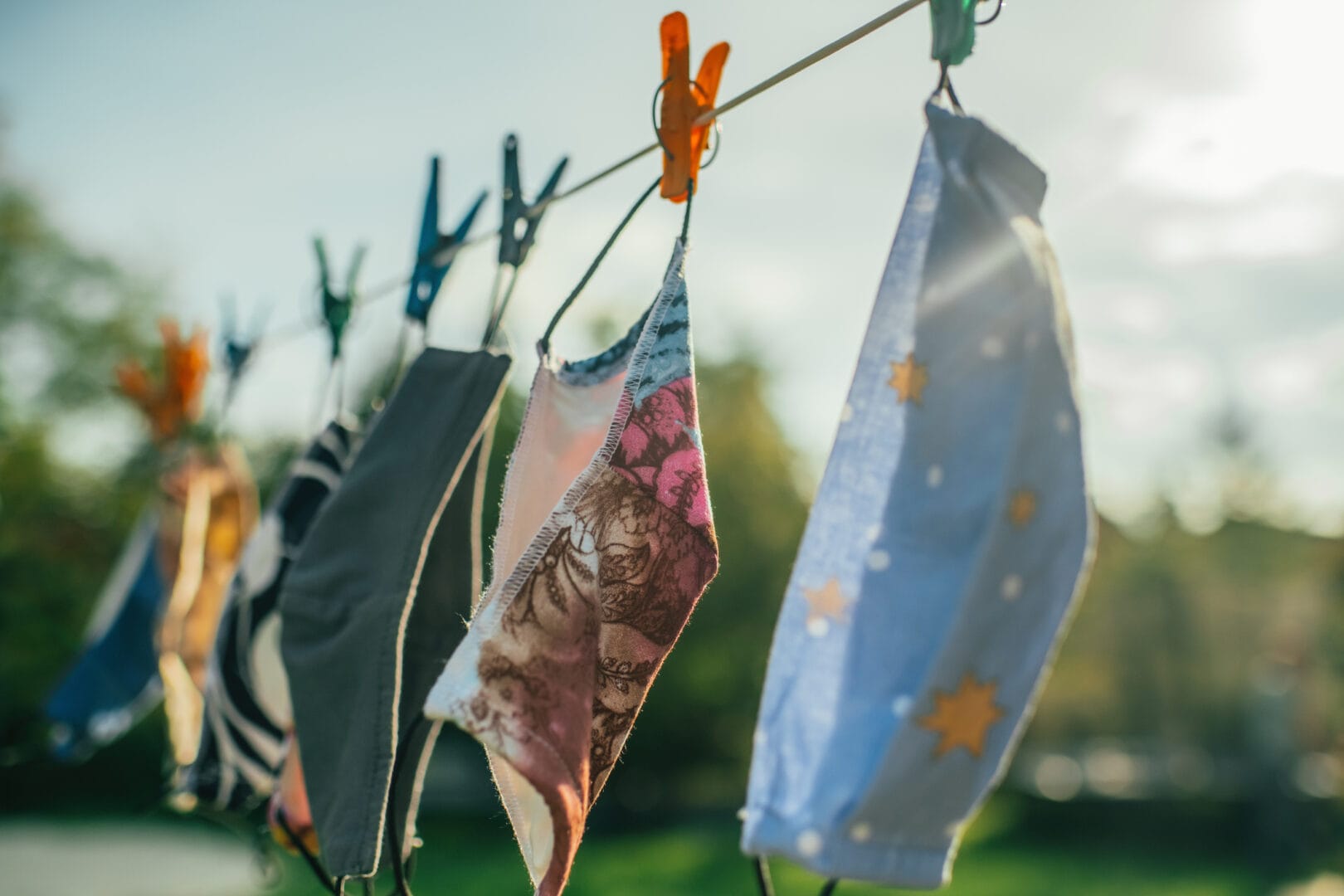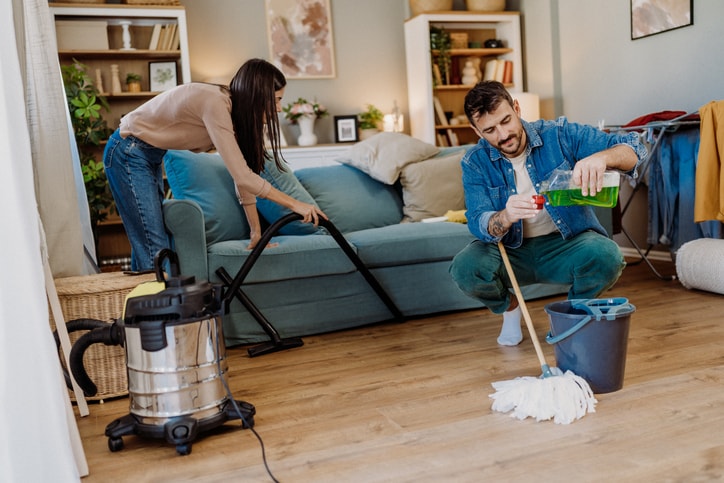Remember spring 2020 and scrubbing all of your individual grocery items when you got them home? For many of us, that seemed like an utterly tedious but important protocol when COVID was new, and nobody — not even the world’s top scientists and doctors — seemed to know how the novel virus really spread.
While the virus is unfortunately still a fact of life these days, we, fortunately, have a lot more data on how it’s transmitted (mainly by way of respiratory droplets from person to person) — and how it’s not transmitted (transmission is far less common by way of surfaces, for instance). So health officials say the most important things you can do include getting vaccinated, wearing a mask, social distancing and practicing good hand hygiene.
That said, keeping a clean house — even hiring a skilled pro to help if possible — can help with both risk mitigation and peace of mind during this challenging time. (Plus, doing so can kickstart enduring hygiene habits that can help you keep all kinds of potential contaminants away from babies, vulnerable household members — and everyone else in the home.)
“For SARS-CoV-2 specifically, air transmission is the biggest concern, but it is still possible for droplets on a surface to transmit the virus,” explains Dr. Jeanne Breen, an infectious disease physician and researcher who now serves as a biotech-biopharma consultant in Old Saybrook, Connecticut. “Disinfecting the surfaces in your home on a regular basis, particularly high-touch surfaces, is an easy step to take to help protect your family from COVID-19.”
“Air transmission is the biggest concern, but it is still possible for droplets on a surface to transmit the virus. Disinfecting the surfaces in your home on a regular basis, particularly high-touch surfaces, is an easy step to take to help protect your family from COVID-19.”
— DR. JEANNE BREEN, INFECTIOUS DISEASE PHYSICIAN AND RESEARCHER
Beyond COVID, she says, disinfecting surfaces will help prevent transmission of other pathogens, like the viruses that cause colds and the flu — of particular concern with schools back in session.
As you dig into your cleaning at home, here are eight places to pay special care during the COVID pandemic, according to medical professionals and cleaning experts — and none of them require scrubbing your groceries.
1. Your hands
First, let’s nail the basics: Wash your hands. Do it frequently. And do it well (vigorously, and with soap, for at least 20 seconds).
The Centers for Disease Control and Prevention (CDC) makes it clear: “Keeping hands clean is one of the most important steps we can take to avoid getting sick and spreading germs to others.” Handwashing with soap removes germs from hands, which helps prevent infections. That’s because people often touch their eyes, nose and mouth without even realizing they’re doing it.
2. The air
The virus settles out of the air quickly enough that it’s not a huge risk if you, say, enter a hotel room the same afternoon after another guest who left in the morning. But when you’re sharing a household among people with any exposure, try to keep the air as clean as possible.
An inexpensive home air purifier can help. “Air purifiers can be helpful in some situations, for example, if you have allergies and you buy a purifier focused on removal of allergens from the air,” Breen says. “By themselves, air purifiers aren’t sufficient to protect individuals from SARS-CoV-2, but they can be used together with other methods, like masks and social distancing.”
Dr. Javeed Siddiqui, an infectious disease physician and co-founder and chief medical officer at TeleMed2U, a telemedicine practice in Roseville, California, echoes the importance of air purification as one part of a larger approach. “When used along with other best practices recommended by CDC and other public health agencies, including social distancing and mask wearing,” he says, “filtration can be part of a plan to reduce the potential for airborne transmission of COVID-19 indoors.”
3. High-touch surfaces
Think about the areas in your home that get the most contact with hands throughout the day — and tackle those often. Common high-touch surfaces include door handles, railings, faucets, appliance handles, countertops, TV remotes and light switches.
“Use a disinfectant, not a sanitizer, that is on the EPA’s List N, which is a list of the disinfectants that are EPA approved for use against COVID-19,” Breen says. “A lot of people don’t know that a sanitizer reduces the number of germs, but it does not kill 99.9% of them, so the word ‘disinfectant’ means the germ-killing power is much stronger. There are no sanitizers on the EPA’s List N, only disinfectants.”
“A lot of people don’t know that a sanitizer reduces the number of germs, but it does not kill 99.9% of them, so the word ‘disinfectant’ means the germ-killing power is much stronger.”
— DR. JEANNE BREEN
If you outsource the task to a professional, here’s an idea of what you can expect to pay for house cleaning.
4. Your tech tools
While surfaces like doorknobs and countertops may be top of mind on your cleaning list, you might not as readily think of disinfecting some of the objects you touch most often throughout the day: your tech tools. Most of us touch our phones many times per day, whether in line at the grocery store or at the doctor’s office.
“If you work from home, be sure to regularly clean your desk, keyboard, mouse and desktop or laptop,” explains Dean Davies, a cleaning expert at Fantastic Cleaners, which has offices in the U.S., U.K., and Australia.
5. Anything that comes from outside
Anything that comes from outside the home can be a potential exposure risk. To that end, consider leaving shoes just outside the door — not just for COVID but because it’s a practice that’s logical as part of a household safety protocol.
Think about it this way: Pandemic aside, having a shoe-free house is a popular practice among families with babies: Don’t forget their little hands are crawling all over the same floors where shoes tread.
6. Your car handles
Similar thinking applies to your car. Clean it regularly — at least the handles and other high-touch surfaces — because it’s often the first place you touch when you are leaving the office, picking up kids from child care or running other errands outside the home.
7. Masks
Don’t forget to wash those all-important masks that help keep you and your family safe every day. Reusable masks should be washed whenever they get dirty or at least daily, according to the CDC. “If you have a disposable face mask, throw it away after wearing it once,” the CDC advises. And “always wash your hands after handling or touching a used mask.”
Breen underscores the importance of washing after each use. “Some pathogens can survive on cloth fabrics for up to 12 hours,” she says. “Given that, along with a cloth mask’s exposure to sweat, saliva and makeup, it makes sense to wash your mask after each use.”
“Some pathogens can survive on cloth fabrics for up to 12 hours. Given that, along with a cloth mask’s exposure to sweat, saliva and makeup, it makes sense to wash your mask after each use.”
— DR. JEANNE BREEN
If you’re not washing masks daily, make sure you have an array of them so you can toss them into the hamper after each use. “Cloth masks need to be machine washed and dried thoroughly, ideally after each use,” according to emergency room physician, Dr. Jay Woody, who is also chief medical officer of Intuitive Health and a co-founder of Legacy ER & Urgent Care in the Dallas/Fort Worth region. “Launder it after each use as the front or forward-facing part of the mask can be contaminated, and you don’t want to touch it or cross-contaminate yourself.”
Woody adds that single-use face masks should be handled with care. “Paper masks should be removed with freshly washed hands,” he says. “Remember, the virus is transmitted by touching your face. Paper masks should be rolled and tied with the ear straps ensuring that it cannot come unrolled. Wrap the mask in a clean tissue and dispose of it in a lined trash can.”
8. Clothing, towels and sheets
Breen references the CDC guidance that recommends washing linens in the hottest water possible and drying them completely. Further, she adds, “you should regularly spray your hamper to disinfect it, and wash your hands after handling the dirty laundry.”
What’s the cleaning protocol if someone in your house contracts COVID-19?
If someone in your household gets COVID-19, isolate them alone in a single room if possible. The CDC advises this practice of isolation for 10 days since symptoms first appeared and 24 hours with no fever without the use of fever-reducing medications.
“The room in which the infected individual is quarantining should have good air circulation, if possible, opening windows to allow for outdoor air to move through,” Siddiqui says. “Any door handles or doorknobs that the infected individual comes in contact with should be wiped down with a disinfected immediately. Some families have elected to use disposable plates, utensils and cups in order to further decrease the risk of contamination/transmission.”
When cleaning due to an infection, don’t forget about all the little things the infected person might touch in the home that could transmit the virus if not sanitized: “Make sure to clean their thermometer if you need to use it with isopropyl alcohol,” Davies says. “Used cutlery and dishes must also be washed at high heat on a daily basis.”



